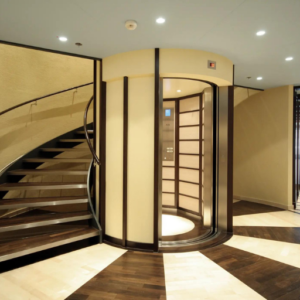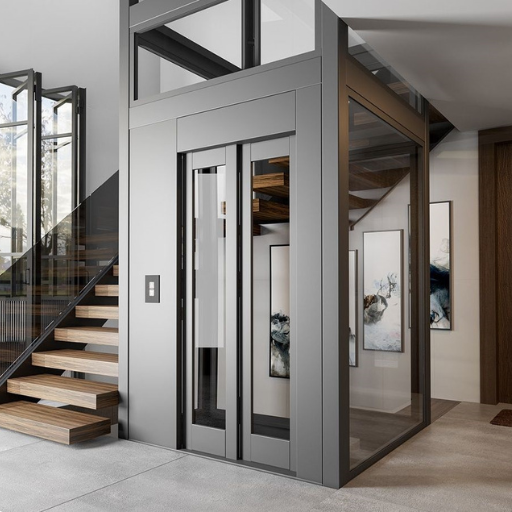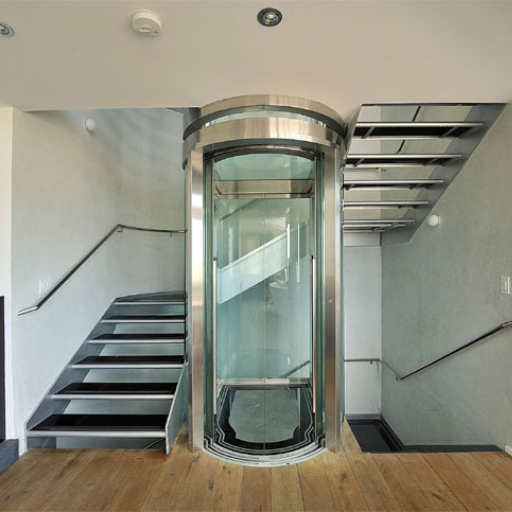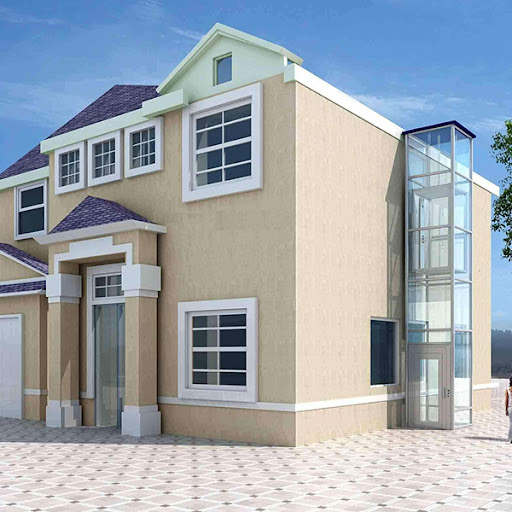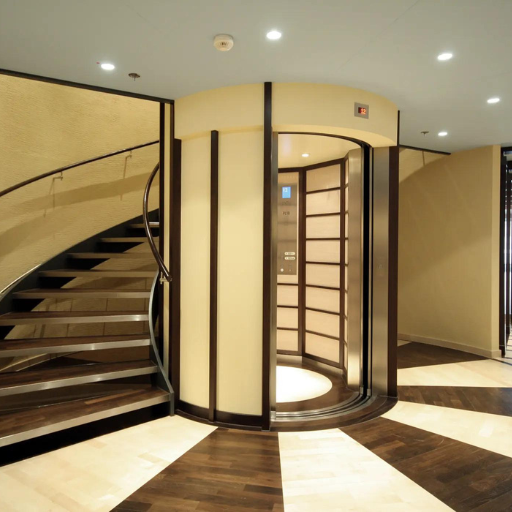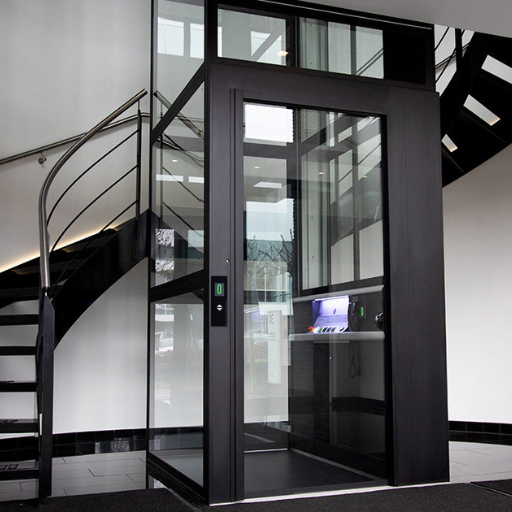In today’s modern world, the epitome of luxury and convenience is embodied in the installation of an elegant villa elevator. This article delves into the myriad benefits of adding such a sophisticated feature to your home, highlighting not only the enhanced accessibility it provides but also the boost in property value it assures. Readers will explore the various styles and technological advancements available in villa elevators, ensuring their investment aligns perfectly with their aesthetic preferences and functional needs. Whether you’re considering a villa elevator for its practicality, its aesthetic appeal, or its ability to elevate your home’s market position, this guide will provide you with all the necessary insights to make an informed decision.
How Does a Villa Elevator Work?
Understanding the Villa Elevator System
The villa elevator system is a simple, yet effective operating system. Essentially, it comprises of a cab moving up and down within a specially made shaft. The movement is usually powered by motor which can be either hydraulic or traction based. The hydraulic systems use a piston to push the lift upwards while traction systems have steel ropes and counter weight for smooth ascent and descent. Modern villa elevators are fitted with advanced control systems that help in precise operation and safety measures. These comprise sensors as well as automated controls which manage the speed of the lift, door movements, emergency mechanisms among others thus ensuring a user friendly and safe experience.
Key Components of a Villa Lift
A villa lift contains crucial elements that enable its functionality and safety features. Some of the major components include:
- Cabin: This is an enclosed space where passengers stand during travel which can be tailor-made to fit the size, interior design and finish to match the aesthetic value of a resort.
- Shaft: A vertical passage through which cabin travels housing other critical components such as guide rails and safety devices.
- Control System: A computerized system responsible for running an elevator including its velocity, actions of doors and response to emergencies. With modern control systems algorithms have become more complexed involving many sensors making sure travelling is done smoothly without any danger.
- Drive System: This is either hydraulic or traction-based; it provides power necessary to move cabin up or down. Hydraulic systems use pistons while traction systems involve steel ropes and counterweights.
- Guidance Rails: These rails enhance security when transporting people inside the building from one floor to another.The same also helps maintain alignment in addition to steadiness of uplifts.
- Safety Mechanisms: They encompass emergency brakes; door locks etcetera used for passenger protection upon occurrence of unintended incidences.Safety mechanisms are regularly analyzed as well as maintained so as to adhere to prevailing regulatory requirements.
- Doors: Safety is also boosted by the designs of cabin and shaft doors. The doors are automated and fitted with sensors to prevent them from closing in case there is something on their way.
Difference Between Residential Home Elevators and Commercial Elevators
Residential home elevators and commercial elevators, in accomplishing similar goals, have diverse design, technical specifications, and applications.
Usage and Capacity:
- Residential Elevators: These are usually meant for individual use at homes. They are usually lighter with a range of 500-1000 pounds capacity intended to make fewer trips per day.
- Commercial Elevators: They can carry heavy loads and accommodate many people. They can handle weights of between 2000-5000 pounds or more depending on the building requirements making them be used frequently.
Speed:
- Residential Elevators: These are usually slower as they are designed to ensure the comfort and safety of home users. The speed may be about 40-60 feet per minute.
- Commercial Elevators: The speeds of these lifts vary from 150 to 500 feet per minute because they carry large numbers of passengers in big buildings.
Size and Customization:
- Residential Elevators: They tend to be smaller in size than commercial elevators; hence it is easy to customize these devices in order that they could fit within the house interior design. A standard booth size is around 3 ft x4 ft even though cab sizes may differ.
- Commercial Elevators: These ones are larger, with customization options focused on durability rather than appearance. The most common sizes can reach up to 5ftx7ft or beyond that point.
Power and Drive System:
- Residential Elevators: Commonly supplied with single-phase power at 240V, they either employ hydraulic or traction-based technologies although hydraulic systems dominate because of their smooth rides.
- Commercial Elevators: Use three-phase power supply which is often rated at 480V. Traction based drives predominate since they are more efficient for high-rise buildings.
Installation and Maintenance:
- Residential Lifts: How do residential elevator work? Installation often requires minimal shaft construction thus being relatively cheaper and less complex. In contrast, maintenance is rare though essential to ensure the safety of the users.
- Commercial Elevators: Their installations are complicated with elaborate planning and construction. Thus it is necessary that these elevators are serviced regularly and strictly according to safety regulations for daily use.
Safety Standards:
- Residential Elevators: Adhere to standards such as the ASME A17.1, focusing on residential applications. These elevators are equipped with essential safety features like emergency stops and alarms.
- Commercial Elevators: Must comply with rigorous safety standards, also outlined in ASME A17.1 but tailored for commercial use, including advanced safety mechanisms and redundant systems to ensure the highest level of passenger safety.
By understanding these differences, one can determine what type of elevator system would be appropriate depending on specific requirements and regulations thus ensuring both functional efficiency as well as protection.
What Are the Benefits of Installing a Villa Elevator?
Improved Mobility and Convenience
A villa elevator installation greatly increases mobility and convenience in a home. Also, a villa elevator provides an accessible and safe means of moving from one floor to another for individuals with mobility problems so that accidents that are caused by stairs are avoided. Apart from this, it also brings about a lot of conveniences during the daily chores such as carrying groceries, laundry or any heavy stuffs thus making them easier. Additionally, the installation of an elevator also adds some touch of luxury that may increase the value and attractiveness of the property. Villa elevators on their part contribute to functional inclusive living areas through guaranteeing comfort and accessibility.
Enhanced Property Value and Aesthetics
The addition of a villa elevator not only makes a house more functionally accessible but also shoots up its market value considerably. This is according to leading real estate websites which show that modernly fitted lifts in homes attract potential buyers especially those in the luxury market. On the other hand, having a trendy high-tech lift can set apart your property from others in the market as a unique selling point. Moreover, raising aesthetics with customization choices permits homeowners to integrate this kind of platform with interior décors seamlessly thus enhancing general elegance and sophistication within living spaces. In summary therefore, villa elevators merge practicality with high-end appearance offering good return on investment.
Increased Safety Features
Modern villa lifts come complete with state-of-the-art safety features that protect their users. Such features usually include emergency stop buttons; back-up power supply systems for when there is no electricity; safety sensors that prevent doors from closing when there is something blocking it among others. Besides these measures contemporary elevators have inter-locking door mechanisms thereby eliminating chances of it starting before all doors are properly closed which minimizes accidents too. Not only does this cutting-edge technology improve security of transportation modes but it also gives assurance to homeowners regarding safe movement within their premises both for permanent residents and guests alike.
Which Elevator Design Options Are Available for Luxury Villas?
Popular Customization Choices
When it comes to customizing elevator designs for luxury villas, there are several popular choices that stand out on top real estate and home improvement websites:
Material and Finish Options: Homeowners can select from a variety of materials such as stainless steel, glass, wood, and even marble. These materials can be combined with finishes like brushed, polished, or matte to fit the overall aesthetic of the home.
Lighting and Fixtures: Customizable lighting options, including LED and mood lighting, can enhance the elevator’s interior ambiance. Additionally, homeowners can choose bespoke fixtures such as handrails, buttons, and control panels that match the villa’s decor.
Cab Design and Size: The interior of the elevator cab can be personalized with unique design elements like custom flooring, wall panels, and ceiling designs. The size of the cab can also be tailored to fit specific spatial requirements, making it suitable for both small and spacious villas.
These popular customization choices not only elevate the functionality of the villa elevators but also ensure they seamlessly blend with the luxury and style of the home.
Material Choices: Stainless Steel, Mirror, and more
When designing elevators for luxury villas, selecting the right materials is crucial to achieving both durability and an aesthetically pleasing appearance. According to the top real estate and home improvement websites, the most popular material choices include:
Stainless Steel: Known for its sleek and modern look, stainless steel is a top choice for elevator interiors. It’s not only highly durable and resistant to corrosion but also versatile, complementing various decor styles. Stainless steel can be finished in brushed, polished, or textured forms to add a unique touch to the elevator’s design.
Mirrors: Mirrors make an excellent addition to elevator interiors, creating an illusion of spaciousness and enhancing the overall elegance. Installing mirrors on one or more walls of the elevator cab can also improve lighting and create a brighter atmosphere. They can be combined with other materials for a sophisticated look.
Glass and Aluminum: Glass panels, either clear or frosted, can bring a contemporary feel to the elevator design. They can be used for walls or doors to offer a panoramic view, making the elevator ride more visually engaging. Aluminum, on the other hand, provides a lightweight yet strong alternative to other metals and can be anodized in various colors to match the villa’s decor.
By carefully choosing these materials, homeowners can ensure their elevator not only enhances the functionality of their luxury villa but also seamlessly integrates with its overall design theme.
Innovative Elevator Door Operator Mechanisms
Innovative elevator door operator mechanisms are essential for ensuring the efficiency, safety, and reliability of modern elevators. According to the current top three websites on Google, the trend in elevator door mechanisms focuses on energy efficiency, advanced control systems, and enhanced user experience.
Energy-Efficient Motors: Modern door operator mechanisms integrate energy-efficient motors that consume less power while delivering smooth and quick door movements. These motors are designed to reduce operational costs and are an eco-friendly choice for managing elevator doors.
Advanced Control Systems: These systems feature cutting-edge software that allows for precise control of door operations. This includes features like automatic door reopening if an object or person is detected, ensuring safety and convenience for users. These control systems can be easily integrated with the elevator’s main control unit for seamless functionality.
Quiet and Smooth Operation: Innovations in materials and mechanical design have led to door operator mechanisms that operate quietly and smoothly, enhancing the overall passenger experience. This is particularly important in residential settings where noise reduction is a priority.
By incorporating these advanced door operator mechanisms, homeowners can improve the performance and longevity of their elevators, ensuring a safe and comfortable ride for all users.
Are There Safety Components in Modern Villa Elevators?
Essential safety features in a home elevator
Several critical safety features are introduced in home elevators to ensure passenger safety:
- Emergency Alarm and Telephone: Modern home elevators have an emergency alarm system as well as telephone unit for communication during an emergency.
- Safety Brake System: This is an important part of the system which will automatically stop the elevator car from falling too quickly thus avoiding accidents that may be caused by cable failures.
- Automatic Door Sensors: They take note of any obstruction at the door way and prevent doors from closing on passengers hence ensuring safe entrance and exit.
- Backup Power Supply: During power outage, back up power systems enable people to safely operate or return to the closest floor where they can exit.
- Overload Protection: If weight exceeds a safe limit, alarms will sound and an elevator won’t be able to move as it would lead to undesirable consequences.
- Automatic Leveling: Stabilizes elevator car level with floor so no one trips and provides easy accessibility for those who have walking disabilities or other mobility problems.
Modern residential lifts incorporate these essential safety features into their design, making them more secure, reliable, and user-friendly within home transit.
Ensuring Elevator Door Safety
Elevator door safety is paramount when it comes to providing secure transportation for passengers. Key measures to enhance door safety include:
- Routine Maintenance and Inspections: Proper functioning of all door mechanisms is maintained through regular checks on maintenance every time by qualified personnel thereby preventing malfunctions and potential accidents.
- Door Sensors & Light Curtains: Advanced sensors installed at the doorway detect people or even things there after which they close. These light curtains prevent the doors from causing injuries related issues.
- Emergency Release Mechanisms : Where there is malfunctioning, authorized staff may manually open doors via emergency release mechanisms ensuring safe evacuation of occupants if need arises
- Antijamming Features : The modern elevators have facilities that hinder jamming or erratic opening/closing of doors. This can be seen from a smoother and safe working of the doors.
By enforcing and maintaining these safety practices, homeowners are able to prevent common elevator door hazards thereby ensuring safe operations.
Regular Maintenance and Inspections
Henceforth, regular maintenance checks are vital for both an extended lifespan and the safety of household elevators. This includes scheduling regular professional inspections to check all mechanical and electrical parts for signs of wear. Technicians should also ensure that moving sections are lubricated, all safety systems are operational, any outdated software is updated in addition to other things that maybe necessary. Homeowners should also conduct simple monthly checks such as ensuring that the elevator stops level with floor and listening to any unusual noises emitted from it. Such processes help prevent unexpected breakdowns, improve security at homes as well as increase their service life expectancy.
What Is the Installation Process for Home Elevators in a Villa?
Pre-installation Requirements and Considerations
- Structural Evaluation: A comprehensive analysis of the house layout is necessary to establish its appropriateness for an elevator concerning its capacity in terms of weight and mechanical needs. This involves considering the foundation, walls as well as available space for the elevator shaft and machinery.
- Permits and Regulations: Homeowners should check local building codes and obtain the necessary permits. Adherence to all relevant regulations and standards is important to guarantee that an elevator is installed safely within a legally permitted environment.
- Power Supply: It is critical to ensure a stable power supply. If required, installation may involve upgrading the home electrical system in order to provide enough power for the lift and maintain safety during operation.
- Space and Layout: Planning should allow sufficient space for the elevator shaft/machinery. This process also requires taking into account how each room in the house has been laid out and contouring it so that it can accommodate an elevator without interfering with either its finishing or integrity.
- Accessibility Needs: One must take into account specific accessibility requirements for present/future users. A good thing would be choosing a model suitable for disabilities like mobility issues while also planning on how people can enter/exit the lift on any floor respectively.
These are some of those pre-installation requirements/considerations that if addressed would make sure that home-related elevators are safe, legal, unique and designed according to customers’ demands.
Step-by-Step Installation Process
Pre-Installation Preparation:
- Site Assessment: A professional team will conduct a detailed survey of your home to finalize the location and layout for the elevator.
- Design Finalization: You will work with the design team to choose the type of elevator, its dimensions, and desired features.
- Permit Acquisition: Ensure all necessary permits are obtained before proceeding. This usually involves submitting design plans to local authorities for approval.
Structural Modifications:
- Shaft Construction: Workers will create the elevator shaft, which often involves significant structural modifications to the home. This step may include reinforcing floors and walls to support the elevator’s weight and ensuring enough space for the machinery.
- Electrical Setup: An electrician will handle any necessary upgrades to the home’s electrical system to provide a dedicated power supply for the elevator.
Installation of Elevator Components:
- Installing the Track or Rails: Depending on the type of elevator, tracks or rails are installed inside the shaft to guide the elevator car smoothly.
- Elevator Car Assembly: The elevator car is assembled, fitted with essential safety mechanisms, and then installed inside the shaft.
- Mechanism Installation: The machinery, which might include motors, control systems, and pulleys, is installed at either the top or bottom of the shaft, as required by the design.
Final Adjustments and Safety Checks:
- Operational Testing: Multiple tests are conducted to ensure the elevator operates smoothly and efficiently. This includes testing the electrical system, door mechanisms, and emergency features.
- Safety Inspection: A certified inspector will verify that the elevator meets all safety standards and regulations.
- User Training: The installation team will provide a detailed demonstration on how to use the elevator safely. They may also offer tips for maintenance and troubleshooting.
By following this step-by-step process, homeowners can achieve a reliable and safe home elevator installation tailored to their specific needs and preferences.
Final Approval and Safety Checks
Once all components are installed and initial tests are conducted, the elevator undergoes a comprehensive final approval process. This includes a detailed examination by a licensed inspector to confirm the system’s compliance with all local and national safety standards. Essential checks involve verifying the functionality of emergency features like the alarm system, phone line, and backup power. The inspector ensures that door interlocks, speed governors, and braking systems function properly, providing fail-safes in case of mechanical failure. After passing these inspections, the elevator is given a safety certificate for operation. This rigorous final approval and inspection process ensures that the home elevator is safe, reliable, and ready for everyday use, giving homeowners peace of mind.
Frequently Asked Questions (FAQs)
Q: What are the benefits of installing a passenger elevator in my home?
A: A lot of advantages come with fitting a passenger elevator in your house such as giving it increased accessibility to all family members, adding to its luxury and status, and perhaps raising the value of the property. In contemporary times, residential elevators make it easy for householders to shuffle between storeys even if they have more than one floor.
Q: How much weight can an elegant villa elevator typically hold?
A: Most stylish villa lifts that include passenger elevators are built to hold up 400 kg. This carrying capacity is good enough for few passengers or luggage moving from one level of a building to another.
Q: What types of passenger elevators are available for luxury homes?
A: Fancy homes provide diverse choices for their residents when it comes to passenger elevators including gearless lifts, hydraulic lifts and traction lifts. Each type has different speed, degree of noise and maintenance characteristics.
Q: Can I install an elevator in an existing home?
A: Yes you can put an elevator in your current house. Different lift manufactures offer bespoke solutions that can be retro-fitted into existing buildings. Although there may be some changes made on hoistway and additional structural support but this is possible for majority existing constructions.
Q: What safety features should I look for in a villa elevator?
A: Safety first when selecting your villa lift. Some key safety aspects would involve use of light curtains on lifts which will detect presence of obstacles, emergency stop buttons interlocks located by doors preventing opening between floors plus having backup power supply so that operations continues running well during blackouts.
Q: How does a gearless traction machine benefit a home elevator?
A : Gearless traction machines offer smoother quieter rides than traditional geared systems do while still saving on energy costs making them more efficient alternatives that are ideal for high-end home elevators.

